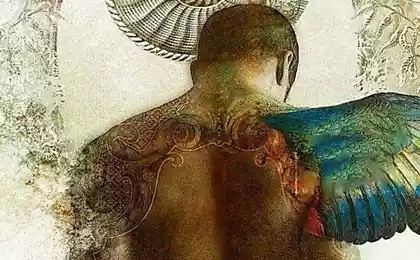460
Psychosomatic disorders — to treat the cause and not the symptoms
The relevance of this topic due to the fact that despite the popularization of psychosomatic concepts from Louise hay and brochures "Heal yourself", to more scientific concepts of self-diagnosis and treatment, the formal aspect of diagnosis remains with the medical professionals, primarily psychiatrists and other specialists of mental health services.
What is stated in ICD-10?
In the International Classification of Diseases 10 psychosomatic disorders can be classified into the following sections: Organic, including symptomatic, mental disorders" (filed F04–F07 corresponding to the exogenous type reactions K. Bonhoffer), "Depressive episode" (heading F 32.0–32.2.) "Neurotic, stress-related and somatoform disorders (F44 headings.4–F44.7, corresponding to the psychogenic and F45 – somatoform disorders), and Behavioral syndromes associated with physiological disturbances and physical factors" (column F50–F53).
Here you can already notice an important caveat: the absence in the present rubrics of the term "psychosomatics", which from the standpoint of ICD-10 can be regarded as an anachronism. However, he continues to live his life and not lose an urgency of usage among professionals. Well, as they say, ICD-10 was created for diagnoses, but not for people.
Despite this outwardly scattered under the headings of the ICD-10 picture, all of these diagnoses share a common feature – a combination of disorders the somatic and psychic spheres and related features of care of patients, which involves close cooperation between psychiatrists, psychotherapists and General practitioners, performed either in medical institutions General practitioners, either in specialized offices and psychosomatic clinics.

What prevents professionals to diagnose these disorders and to provide assistance aimed at treating the cause and not the symptom ?
1. Temporary restrictions the doctor
Fear of doctors is too much of a waste of time for psychological problems. Think about it: according to statistics of the Ministry of health, in accordance with the standard norms, the doctor needs to spend on a conversation with the patient to 5.5 minutes to complete the questionnaire 5.5 minutes, and the inspection takes 3-4 minutes.
According to experts, in the countries with a high level of medical services to communicate with patients takes 7-9 minutes. Whether during this time the specialist to efficiently collect anamnesis, to examine the context of the emergence of symptoms to develop a hypothesis about a possible connection with psychosocial stressors, to identify elements of secondary gain factors support illness, etc.? A very difficult task, and the rush is rarely related to quality of diagnosis.
2. The time constraints of the patient
If you've read the article up to this paragraph, that's good. The average duration of viewing articles and video content on the Internet little more than a minute. The pace of life grows, cities grow, communication becomes faster and easier. Quiet village life, where letters had to wait for weeks, and time to think, to feel, to podumatj yourself, your body, it seems that in the past. To this point I would like to quote 125 years ago:
"In the big city poor people to live well, very well. In a big city a person can live a hundred years and not miss the fact that he is long since dead and rotted. Understand that he, once, all things, things, things, things, office, home, cultural..."
(L. N. Tolstoy "Kreutzer Sonata")
No time, no feelings, no man, no problem. To incorporate into this formula a visit to a therapist all the more difficult.
3. "Stigma"
Term that refers to social stereotypes, disregard or mistrust everything to do with mental disorders. If the European countries take a sick leave in connection with depression, not only is the infamous and sometimes coveted (my friend, a Russian immigrant for several years gets a good allowance with a long depression, in a small but highly developed European country), diagnosis and treatment of depression, neurotic disorders in the former Soviet Union firmly associated in patients with labeling "mentally ill". As a result, feelings of shame and guilt of the patient lead to the patient potentially contain important information and additional difficulties in diagnosis.
4. "Tacit agreement" between doctor and patient
The above items 1, 2 and 3 logically lead us to this result. Indeed, it is much easier to talk about somatic symptoms than psychological difficulties, analyze the system, the meaning of the symptoms or just to organize additional diagnostic consultation at the psychotherapist. What extra excitement?
5. Depression without depression
Depression doesn't always have to be "normal," i.e. typical complaints and feelings of low self-esteem, guilt, apathy, lethargy, etc. Although these symptoms are fairly typical, they are not always voiced as complaints. For some patients it is more visible and amenable to verbalization of the complaint are purely somatic in nature.
6. The feeling of self-incompetence
Therapists and other somatic professionals can attend to the conclusion that "psychiatric case". However, the quality of diagnostics and treatment is our General, professional business, where the same number is involved and the patient, performing an active role of a subject of care, not a passive object of medical manipulations.
7. Unilateral medical education
Biological reductionism in the training of medical students, all causes and disease processes are reduced to biological factors. Psychosocial mentioned in passing or ignored altogether. Such topics as "the psychology of the patient", "Internal picture of the disease" are often perceived as continuous, distracting from the more important "real medical issues."
I remember when I lectured in psychiatry, doctors-interns, devoted 2 days to discussing the subject of personal characteristics, family relationships, characteristics of an Alliance with depressive patients in the end, and asked: "are There any questions?", my future colleague raised his hand and asked an honest question: "It's interesting, of course, but in the end, it's all a problem of low serotonin levels in the synaptic cleft?" Curtain.published
Author: Anton Ezhov
P. S. And remember, only by changing their consumption — together we change the world! © Join us at Facebook , Vkontakte, Odnoklassniki
Source: psy4psy.ru/diagnostika
What is stated in ICD-10?
In the International Classification of Diseases 10 psychosomatic disorders can be classified into the following sections: Organic, including symptomatic, mental disorders" (filed F04–F07 corresponding to the exogenous type reactions K. Bonhoffer), "Depressive episode" (heading F 32.0–32.2.) "Neurotic, stress-related and somatoform disorders (F44 headings.4–F44.7, corresponding to the psychogenic and F45 – somatoform disorders), and Behavioral syndromes associated with physiological disturbances and physical factors" (column F50–F53).
Here you can already notice an important caveat: the absence in the present rubrics of the term "psychosomatics", which from the standpoint of ICD-10 can be regarded as an anachronism. However, he continues to live his life and not lose an urgency of usage among professionals. Well, as they say, ICD-10 was created for diagnoses, but not for people.
Despite this outwardly scattered under the headings of the ICD-10 picture, all of these diagnoses share a common feature – a combination of disorders the somatic and psychic spheres and related features of care of patients, which involves close cooperation between psychiatrists, psychotherapists and General practitioners, performed either in medical institutions General practitioners, either in specialized offices and psychosomatic clinics.

What prevents professionals to diagnose these disorders and to provide assistance aimed at treating the cause and not the symptom ?
1. Temporary restrictions the doctor
Fear of doctors is too much of a waste of time for psychological problems. Think about it: according to statistics of the Ministry of health, in accordance with the standard norms, the doctor needs to spend on a conversation with the patient to 5.5 minutes to complete the questionnaire 5.5 minutes, and the inspection takes 3-4 minutes.
According to experts, in the countries with a high level of medical services to communicate with patients takes 7-9 minutes. Whether during this time the specialist to efficiently collect anamnesis, to examine the context of the emergence of symptoms to develop a hypothesis about a possible connection with psychosocial stressors, to identify elements of secondary gain factors support illness, etc.? A very difficult task, and the rush is rarely related to quality of diagnosis.
2. The time constraints of the patient
If you've read the article up to this paragraph, that's good. The average duration of viewing articles and video content on the Internet little more than a minute. The pace of life grows, cities grow, communication becomes faster and easier. Quiet village life, where letters had to wait for weeks, and time to think, to feel, to podumatj yourself, your body, it seems that in the past. To this point I would like to quote 125 years ago:
"In the big city poor people to live well, very well. In a big city a person can live a hundred years and not miss the fact that he is long since dead and rotted. Understand that he, once, all things, things, things, things, office, home, cultural..."
(L. N. Tolstoy "Kreutzer Sonata")
No time, no feelings, no man, no problem. To incorporate into this formula a visit to a therapist all the more difficult.
3. "Stigma"
Term that refers to social stereotypes, disregard or mistrust everything to do with mental disorders. If the European countries take a sick leave in connection with depression, not only is the infamous and sometimes coveted (my friend, a Russian immigrant for several years gets a good allowance with a long depression, in a small but highly developed European country), diagnosis and treatment of depression, neurotic disorders in the former Soviet Union firmly associated in patients with labeling "mentally ill". As a result, feelings of shame and guilt of the patient lead to the patient potentially contain important information and additional difficulties in diagnosis.
4. "Tacit agreement" between doctor and patient
The above items 1, 2 and 3 logically lead us to this result. Indeed, it is much easier to talk about somatic symptoms than psychological difficulties, analyze the system, the meaning of the symptoms or just to organize additional diagnostic consultation at the psychotherapist. What extra excitement?
5. Depression without depression
Depression doesn't always have to be "normal," i.e. typical complaints and feelings of low self-esteem, guilt, apathy, lethargy, etc. Although these symptoms are fairly typical, they are not always voiced as complaints. For some patients it is more visible and amenable to verbalization of the complaint are purely somatic in nature.
6. The feeling of self-incompetence
Therapists and other somatic professionals can attend to the conclusion that "psychiatric case". However, the quality of diagnostics and treatment is our General, professional business, where the same number is involved and the patient, performing an active role of a subject of care, not a passive object of medical manipulations.
7. Unilateral medical education
Biological reductionism in the training of medical students, all causes and disease processes are reduced to biological factors. Psychosocial mentioned in passing or ignored altogether. Such topics as "the psychology of the patient", "Internal picture of the disease" are often perceived as continuous, distracting from the more important "real medical issues."
I remember when I lectured in psychiatry, doctors-interns, devoted 2 days to discussing the subject of personal characteristics, family relationships, characteristics of an Alliance with depressive patients in the end, and asked: "are There any questions?", my future colleague raised his hand and asked an honest question: "It's interesting, of course, but in the end, it's all a problem of low serotonin levels in the synaptic cleft?" Curtain.published
Author: Anton Ezhov
P. S. And remember, only by changing their consumption — together we change the world! © Join us at Facebook , Vkontakte, Odnoklassniki
Source: psy4psy.ru/diagnostika























